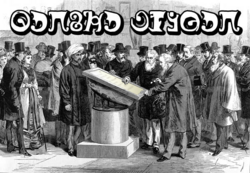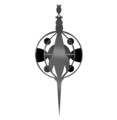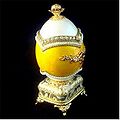Madoka Magica Trivia: Difference between revisions
Artemiszero (talk | contribs) |
(→Opening Animation Sequence: That's really speculah) |
||
| Line 20: | Line 20: | ||
===Opening Animation Sequence=== | ===Opening Animation Sequence=== | ||
Minor differences have been noted in the opening sequence when comparing Episode 1 and 2 with the rest (up to Episode 9). The first subtle anomaly noted is in Madoka's transformation sequence: Episodes 3 to 9 feature rotating runes, whereas the runes in Episode 1 and 2 are moving slo-mo to a point they seem motionless. The second anomaly is found near the end of the OP with the city skyline shots - a golden beam of light can be seen shooting skywards from Episodes 3 to 9, but none in Episode 1 and 2. Note that regardless, the camera still panned upward. Both of these anomalies can be seen as being symbolic in nature, but to what degree? That remains to be revealed. | Minor differences have been noted in the opening sequence when comparing Episode 1 and 2 with the rest (up to Episode 9). The first subtle anomaly noted is in Madoka's transformation sequence: Episodes 3 to 9 feature rotating runes, whereas the runes in Episode 1 and 2 are moving slo-mo to a point they seem motionless. The second anomaly is found near the end of the OP with the city skyline shots - a golden beam of light can be seen shooting skywards from Episodes 3 to 9, but none in Episode 1 and 2. Note that regardless, the camera still panned upward. Both of these anomalies can be seen as being symbolic in nature, but to what degree? That remains to be revealed. | ||
===Family Name=== | ===Family Name=== | ||
Revision as of 04:42, 10 March 2011
This page is about minor facts and observations made throughout the series. For in-depth articles about the setting, please refer to the "Confirmed Theories" category.
You will also find all up-to-date articles (including fan speculations and articles that were proven wrong) on the Articles page.
General
Puella Magi Madoka Magica
Puella Magi was supposed to be latin for "Magical Girl". However, if that was the intended translation, then "Puella Magi" is a mistranslation, and should have been either "Puella Maga" or "Puella Magica".
As-is, "Puella Magi" translates to "Girl of the Sorcerer".
Events of Episode 8 suggest that it may indeed be intentional. When interpreted as "girl [form] of the sorcerer", it fits very well with the fact that Puella Magi are immature forms of witches. It even preserves Kyubey's pun in original Japanese to some extent, although a witch would be more conventionally called "melefica" in Latin, rather than "magus".
About the logo
Japanese fans noticed that the font of the kanji "魔法" (mahou, magic) in the show's logo text is heavily stylized, and could be read instead as "廃怯" (hai-kyou, cowardice, hesitation).
The visually valid joke title, "廃怯少女 まどか☆マギカ" (Hai-Kyou Shoujo Madoka Magika), could be translated as "wavering girl Madoka Magica"
Opening Animation Sequence
Minor differences have been noted in the opening sequence when comparing Episode 1 and 2 with the rest (up to Episode 9). The first subtle anomaly noted is in Madoka's transformation sequence: Episodes 3 to 9 feature rotating runes, whereas the runes in Episode 1 and 2 are moving slo-mo to a point they seem motionless. The second anomaly is found near the end of the OP with the city skyline shots - a golden beam of light can be seen shooting skywards from Episodes 3 to 9, but none in Episode 1 and 2. Note that regardless, the camera still panned upward. Both of these anomalies can be seen as being symbolic in nature, but to what degree? That remains to be revealed.
Family Name
All Magical Girls have personal-name-sounding family names, although this is not particularly uncommon in anime. (See also: Speculah:Name)
Witch's Labyrinth
The labyrinths consist both of elements from their locations in reality and of allusions to the witches that create them. Deeper within the labyrinth, more references to the witch will be seen and fewer elements from reality show up. For example, in episode one, the labyrinth is set in a floor waiting for refurbishing, and it was fulfilled with 'under construction' signs and barriers of a construction site. In episode two, the labyrinth is set in an abandoned concrete building, thus the rooms in the labyrinth are made of solid concrete, making its appearance differ from episode one even though the owner is the same. As the protagonists approach the the final room, elements of a rose garden start to dominate the construction elements. In episode three, the labyrinth is set in a hospital, therefore surgery signs, needles, gallipots and wards are presented first, but deeper in, those are replaced by various kinds of desserts. The barrier can also be influenced by the strong emotions of the people within them, as seen in Episode three when Mami and Madoka make their promise.
Death of Cyrus Hamlin
The editor of the Norton Critical edition of Goethe's Faust, Cyrus Hamlin, passed away on January 19, 2011, the day before the third episode of Puella Magi Madoka Magica aired. While entirely a coincidence, it is nevertheless a mildly eerie coincidence.
- "I do not expect to attempt yet another revision of my notes to 'Faust' -- for that, alas!, life is too short, as both Wagner and Mephistopheles knew -- but I hope on the basis of what is now nearly four decades of work on Goethe's drama to continue indefinitely my exploration into the riches of this unique and inexhaustible masterpiece of our culture." - Cyrus Hamlin, January 2000
If only he could have watched Shaft's exploration.
Soul Gem and Grief Seed
The pin on top of both soul gem and grief seed is also the emblem of the holder, although Witches have a second symbol used for their witch's kiss and barrier. The seed Gertrud holds has a butterfly emblem, which is shown on her minions and her face when she attempted to attack Mami.
Charlotte's seed has a emblem containing concentric circles with ribbons, representing a strawberry. This is also shown on her minions and the other doll sitting at her table which is stomped on by Homura and may have been Charlotte's true body.
The Soul Gem Mami holds has a flower like design, which is the same as her hair accessory and transformation effects, as well as the gem's shape when she is transformed.
While the emblems on the grief seeds are the actual "faces" of the witches, the ones on soul gem could resemble accessories
such as swirls and capes. Also note that the soul gem can abbreviated as SG, while Grief Seed is GS.
It has been additionally observed that the Soul Gems and Grief Seeds are quite similar in design to egg carvings -- particularly Easter Eggs produced by the House of Fabergé in the late 19th Century.
Architecture
See Architecture in the Anime versus Real-Life Architecture.











